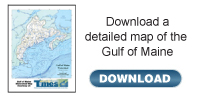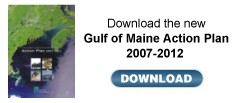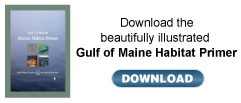Growing seaweed sustainably
By Susan Llewelyn Leach
The clear chilly waters of the Gulf of Maine, as uninviting
as they might seem to land-huddled humans, are perfect for seaweed.
High tides, little heavy industry and thousands of miles of craggy
coastline make it one of the best spots in the world for seaweeds.
So much so that 250 varieties thrive there.
When you add to that the rapidly growing market for seaweed
around the world, you have a small industry bursting to expand
in a region hungry for jobs.

The catch here is that only a certain amount of wild, hand-harvested
seaweed can be pulled from the Gulf’s waters without affecting
the sustainability, or rejuvenation of the crop. And the limits
of some of those harvests are already approaching, said Shep Erhart,
owner of Maine Coast Sea Vegetables in Franklin, Maine, and an
early pioneer of seaweed farming in the Gulf. “We’re
reaching the upper limit of the sustainable harvest for at least
three of our species.” Meanwhile, demand for their products
is growing at 10 to 15 percent a year, he said.
 “Sustainable” is a key word in commercial seaweed
farming. It is a fundamental element in producing an organic crop,
Erhart explained. He claimed his company was the first in the
world to have its seaweed handling and harvesting procedures certified
organic by the Organic Crop Improvement Association, or OCIA.
Although the definition of organic is still up for debate, most
agree sustainability is a key. “Sustainable” is a key word in commercial seaweed
farming. It is a fundamental element in producing an organic crop,
Erhart explained. He claimed his company was the first in the
world to have its seaweed handling and harvesting procedures certified
organic by the Organic Crop Improvement Association, or OCIA.
Although the definition of organic is still up for debate, most
agree sustainability is a key.
The importance of sustainability has spread far beyond proponents
of organic food, however. Growing public awareness of the environment,
along with the devastating consequences of overfishing in the
North Atlantic over past decades, has further sensitized the industry.
Until recently, with the exception of a few experimental cultured
seaweed sites, all the seaweed grown in the Gulf’s waters
has been wild and hand-harvested. Commercial seaweed companies
have taken pains to protect their crop. Take Acadian Seaplants
of Dartmouth, Nova Scotia, which claims to be the world’s
largest independent manufacturer of seaweed-based specialty products.
The company has a sophisticated, internationally-recognized sustainable
harvesting and monitoring program. Each seaweed bed is photographed
from the air and assessed on the ground—with the data recorded
in a computer file—to ensure the crop is managed sustainably.
Alan Critchley, the company’s vice president of research,
said Acadian Seaplants harvests 17 to 25 percent of the standing
stock of rockweed—well below the annual growth rate. The
seaweed’s biomass is also monitored before, during and after
each harvest, Critchley said.
 To avoid the possibility of overharvesting a wild crop, Erhart
plans to add cultured seaweed next year—growing deep burgundy-colored
dulce seaweed on nets and selling it under a “local and sustainable”
label rather than “organic.” To avoid the possibility of overharvesting a wild crop, Erhart
plans to add cultured seaweed next year—growing deep burgundy-colored
dulce seaweed on nets and selling it under a “local and sustainable”
label rather than “organic.”
At the same time, a new twist to the cultured seaweed story is
developing as a number of commercial seaweed operations along
the Gulf coast, including Erhart’s, collaborate with scientists
and researchers. They are experimenting with an integrated aquaculture
idea that is producing some surprising and encouraging results.
Aquaculture is a staple of the fishing industry, but has traditionally
been a monoculture—growing one type of finfish, or shellfish,
in isolation. With integrated aquaculture it is possible to create
mini-ecosystems in the sea whereby the waste of one species, salmon
for example, becomes the food or fertilizer for other species
such as shellfish and seaweed. The setup, first proposed six years
ago, turns out to be a more efficient, economic and ecologically
sensitive way to operate aquaculture.
Thierry Chopin, a researcher at the University of New Brunswick, is at the forefront of this integrated idea, known more scientifically as Integrated Multi-Trophic Aquaculture, or IMTA. When rafts of blue mussels are placed in close proximity to Atlantic salmon cages (within 20 meters or 60 feet), and ropes of kelp (a large brown seaweed) dangle from a raft 100 meters (300 feet) away, the three species complement and increase each other's growth, Chopin discovered.
Fish farms produce an excess of nutrients in the surrounding waters. When kelp is grown near the fish cages, Chopin said, it absorbs much of the excess dissolved inorganic nutrients, such as nitrogen and phosphorus, and increases its biomass 46 percent faster than when grown 1.2 kilometers (0.7 miles) away at a reference site. Meanwhile, the mussels feed on the organic particulates and grow 50 percent faster. This acceleration speeds up the harvesting cycle and turns the natural recycling into an economic benefit.
Shawn Robinson, a government researcher at the St. Andrews Biological Station in New Brunswick, is collaborating with Chopin on the IMTA idea with the help of a local company, Cooke Aquaculture. He said they're at the commercial scale already. Four salmon sites each have four rafts of kelp and four of mussels placed at carefully chosen distances. And the result: enormously plump mussels and fast-growing seaweed. His only concern, Robinson said dryly, is that people might develop a taste for these unusually stout mussels and forget what the wild ones look like . .
On the cusp of larger commercial use, IMTA appears to be a
win-win formula with a further bonus. Despite early concerns that
the shellfish and seaweeds might be “reservoirs” for
diseases that would affect the fish, the reverse has been the
case, Chopin said. “Our team, and also another one in Norway,
have observed that mussels seem to be able to destroy the virus
responsible for ISA (infectious salmon anemia),” Chopin said.
This means the mussels have the potential to act as a bio-filter
for disease reduction or prevention, he added.
One other concern had been that seaweed’s function as
a natural water filter might turn it into a repository for pollutants.
Over six consecutive years, Chopin said, the Canadian Food Inspection
Agency (CFIA) monitored the seaweed for residues of heavy metals,
PCBs and a host of other contaminants, but no accumulation of
chemicals was ever found. The results were always below the regulatory
limits.
 Acadian Seaplants has been working closely with Chopin on the
IMTA experiment and markets the kelp produced. When asked about
the “organic” status of Acadian Seaplants products,
Critchley said the term is loose. All seaweeds enjoy the status
of being an “organic input” for agricultural purposes,
he said. The company’s site at Pennfield, New Brunswick,
is also certified for the production of organic products from
seaweeds. Acadian Seaplants has been working closely with Chopin on the
IMTA experiment and markets the kelp produced. When asked about
the “organic” status of Acadian Seaplants products,
Critchley said the term is loose. All seaweeds enjoy the status
of being an “organic input” for agricultural purposes,
he said. The company’s site at Pennfield, New Brunswick,
is also certified for the production of organic products from
seaweeds.
Erhart of Maine Coast Sea Vegetables said his whole crop is
certified organic by the Organic Crop Improvement Association.
When harvesting in the ocean, he acknowledged, there is little
control of the environment. But where one harvests—far from
industry and flood drains, for example—how, when and how
much are all part of the OCIA assessment. That includes how the
plants are transported, dried, stored and packaged.
While most of us might first think of the dark green or black
crinkly strip wrapped around sushi rice when seaweed is mentioned,
the sea plants’ uses are far and wide. Rich in nutrients
absorbed from the rushing tides, various types of seaweed are
used in products ranging from fertilizers to cosmetics, animal
and human food to vitamin supplements, and pharmaceuticals to
textiles to biotechnology.
The next time you eat ice cream or drink beer, chances are
some rock-clinging seaweed was integral to its production.
Susan Llewelyn Leach is a free-lance writer based in Cambridge,
Massachusetts.
|








